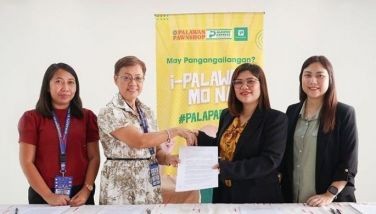MABS sets 3-yr targets
August 3, 2004 | 12:00am
After six years in operation, the RBAP-MABS program has "enrolled" 165 rural bank branches. By 2007, it should reach 350 or more than double the rate of growth and the number of bank branches.
In fact, it plans to aggressively expand in the Autonomous Region in Muslim Mindanao and the conflict-affect areas in Mindanao.
The Rural Bankers Association of the Philippines (RBAP) – Microenterprise Access to Banking Services (MABS) program is jointly implemented by the United States Agency for International Development (USAID) and RBAP, the sole representative of the country’s rural banking system.
The program, which started in 1998, is designed to assist rural banks to profitably provide financial services to the microenterprise sector.
As of end May this year, there were 53,324 micro loan accounts outstanding. By the end of 2007, it is expected to balloon to 250,000.
John V. Owens, head of the MABS program in the Philippines said that the total number of new borrowers who have borrowed from MABS-participating rural banks reached 132,000.
"By the end of 2007, it is programmed to reach the half a million mark," Owens added.
Likewise, the MABS program is envisioned to bring in 400,000 new micro depositors by 2007, from the 220,000 new micro depositors in end May 2004.
Micro deposits are one of the hallmarks of the Philippine rural banking system, which has drawn the attention of different countries practicing microfinance. Most countries have been successful in micro lending but have been unable to stimulate deposit generation in significant amounts.
It has already developed the bank management software customized for Philippine rural banks called the Rural Bankers 2000 (RB 2000), which also includes features essential to the prudent management of microfinance loan and deposit services.
Over 71 rural banks are already utilizing the software and it will soon be updated to include credit bureau reporting and the automated credit bureau interface.
The development of the credit bureau-related software is in coordination with the Bankers Association of the Philippines (BAP), the counterpart in the commercial banking sector of the RBAP.
The BAP-RBAP alliance should result in the development of the negative file information system (NFIS) to rural banks. The NFIS is a shared reference database containing negative data on credit histories, including information past delinquencies.
Owens said that the MABS program would continue to conduct workshops, seminars and training programs to expand microfinance services. It includes microfinance, MIS systems, loan pricing, deposit mobilization, microfinance lending, zero tolerance towards delinquency, financial management, business planning, market analysis and product development, internal control, and fraud prevention. – Ted Torres
In fact, it plans to aggressively expand in the Autonomous Region in Muslim Mindanao and the conflict-affect areas in Mindanao.
The Rural Bankers Association of the Philippines (RBAP) – Microenterprise Access to Banking Services (MABS) program is jointly implemented by the United States Agency for International Development (USAID) and RBAP, the sole representative of the country’s rural banking system.
The program, which started in 1998, is designed to assist rural banks to profitably provide financial services to the microenterprise sector.
As of end May this year, there were 53,324 micro loan accounts outstanding. By the end of 2007, it is expected to balloon to 250,000.
John V. Owens, head of the MABS program in the Philippines said that the total number of new borrowers who have borrowed from MABS-participating rural banks reached 132,000.
"By the end of 2007, it is programmed to reach the half a million mark," Owens added.
Likewise, the MABS program is envisioned to bring in 400,000 new micro depositors by 2007, from the 220,000 new micro depositors in end May 2004.
Micro deposits are one of the hallmarks of the Philippine rural banking system, which has drawn the attention of different countries practicing microfinance. Most countries have been successful in micro lending but have been unable to stimulate deposit generation in significant amounts.
It has already developed the bank management software customized for Philippine rural banks called the Rural Bankers 2000 (RB 2000), which also includes features essential to the prudent management of microfinance loan and deposit services.
Over 71 rural banks are already utilizing the software and it will soon be updated to include credit bureau reporting and the automated credit bureau interface.
The development of the credit bureau-related software is in coordination with the Bankers Association of the Philippines (BAP), the counterpart in the commercial banking sector of the RBAP.
The BAP-RBAP alliance should result in the development of the negative file information system (NFIS) to rural banks. The NFIS is a shared reference database containing negative data on credit histories, including information past delinquencies.
Owens said that the MABS program would continue to conduct workshops, seminars and training programs to expand microfinance services. It includes microfinance, MIS systems, loan pricing, deposit mobilization, microfinance lending, zero tolerance towards delinquency, financial management, business planning, market analysis and product development, internal control, and fraud prevention. – Ted Torres
BrandSpace Articles
<
>
- Latest
Latest
Latest
September 11, 2024 - 2:00pm
September 11, 2024 - 2:00pm
June 28, 2024 - 2:55pm
June 28, 2024 - 2:55pm
Recommended
November 30, 2024 - 12:00am





























